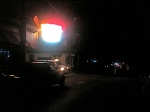5 September 2012
So, there wasn’t too much going on for John Cage’s 100th birthday in New Orleans. Indeed, Googling the words ‘”John Cage” Centennial “New Orleans”‘ actually brought me to a few entries on my own blog. So, my friend and housemate, Joe, listened to all John Cage while at home that day. I was in the midst of packing, so it was my accompaniment to that. I listened to The Seasons three times, because I love it so much, most of Roaratorio : An Irish Circus on Finnegans Wake, many of his early pieces, including some of the recordings featuring the extraordinary voice of Robert Wyatt, from the Obscure Records LP, released in 1976. One of my favourite records, period. His voice is perfect for those songs.
Joe also accompanied me to Frenchman Street while I sold art that night. Before going down there I stopped at a FedEx store on Canal Street, and made a few copies of this poster I made. The man working there had a big beard, was very friendly, and seemed to have a few artistic tendencies, so I asked him if he knew of John Cage. He said no, but asked if he might recognise any of his work. I told him about the silent piece, 4’33”, how controversial it was and continues to be, why it’s important and so forth. He responded with an indifferent “hmm”, and then wished me a good evening.
I set up my art on Frenchman Street where I normally do, near my good friend Erin, who writes poetry on her typewriter. Joe decided it was a night to film, so he did, as inconspicuously as he could. For the longest time no one said anything about the image. And then, out of the blue, a middle-aged woman, dressed for the night with makeup, jewelry, heels and the works, screamed “Ah, John Cage !” and enthusiastically pointed at the picture. I replied calmly, “Oh, you know him ?” And to that, she replied, “Yes, I’m Merce Cunningham’s niece !” I was shocked. Completely lost for words. It took me a while to piece together those five words, but after an unidentifiable amount of time, it all made sense. Or, of course, as much sense as that statement can make on John Cage’s 100th birthday in New Orleans. She continued to explain more of the obvious : that she was, in fact, Merce’s niece. She then told me how she had dinner with John many times, how he always had a sparkle in his eye (I knew that … ), and how kind and warm he was, always. It was so lovely to hear all those things. We talked a bit more, about the Cornish School, Seattle, mushrooms, and so on. She was very friendly and happy to know that many younger people are interested in Merce’s and John’s work, if not more than before. So it was a good conversation to have !
That’s about it. I could go on and on about the very drunken electrician from Pennsylvania who was shipped in with his company to work on the power outages in New Orleans post Hurricane Issac, and how he stayed with us for at least an hour, talking in layers of intoxicated circles about fixing telephone wires, the translation of Baton Rouge, the State of Georgia, his childlike ideas on art (uninhibited, fresh and flawed), and Erin’s hair. But I don’t have time to write much more. (Writing from West Texas at the moment.) But it’s worth it to say that he was one of the three people who bought something that night (this print), one featuring an abstracted cascade of loosely rendered flowers.









